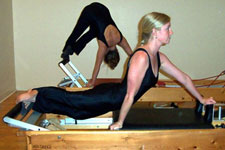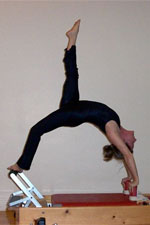
The Pilates Teacher Training Program
Faculty members from the Department of Theatre and Dance offer a comprehensive teacher training program in Pilates every other year. The emphasis of the program is to produce quality teachers trained in the authentic, classical, style of Joseph Pilates. This unique program combines six (6) hours of academic coursework in Pilates with spring/summer intensive training, assessment, and an apprenticeship.
Pilates Teacher Training Program 2027
The next Pilates Teacher Training Program will occur in spring and summer 2027. Click information for fees, schedule, and registration from the 2025 training. Email Rebecca Quin, hower@appstate.edu with questions.
Puh-LAH-teez, What is it, anyway?
 The Pilates method, as Joseph Hubertus Pilates originally defined it in the early 1920's, was called "Contrology", or the art of control, based on the ideal of attaining a complete coordination of body, mind, and spirit. To develop his method, Pilates studied and drew from both Eastern and Western practices, including yoga, Zen meditation, and ancient forms of Greek and Roman exercise.
The Pilates method, as Joseph Hubertus Pilates originally defined it in the early 1920's, was called "Contrology", or the art of control, based on the ideal of attaining a complete coordination of body, mind, and spirit. To develop his method, Pilates studied and drew from both Eastern and Western practices, including yoga, Zen meditation, and ancient forms of Greek and Roman exercise.
As a frail child, Pilates suffered from asthma, rickets and rheumatic fever, thus his early efforts towards self healing explored a multi-layered approach to building strength, body awareness, breath control, and increasing flexibility in a balanced way. Very early in his career, he also worked as a boxer, a circus performer, and a self-defense trainer. Due to his varied perspectives, this body-mind approach to exercise makes Pilates particularly effective as a rehabilitative tool, recognizing the role that kinesthetic awareness or mindfulness play in efficient physical re-patterning.
 The emphasis on mind-body approach is further elucidated by the principles (CCCPFB) that Pilates founded his "exercises" on: Centering, concentration, control, precision, flow, and breath. Centering, as in Yoga, refers to the ability to focus the attention on one small sensation; in this method, it might often be a particular area of the core trunk muscles, awareness of the ability to release tension, or simply the exertion of breath. Concentration specifically refers to the mind/ body connection, the ability to focus your attention as the mind wills the body into action. Control promotes injury prevention and gives empowering benefits: physical control promotes mental control, which promotes physical control. Precision, or the ability to avoid sloppy, mindless movements, increases the likelihood of producing the desired results. Flow relates to transitional ability, the ease with which we flow from one experience or exercise to the next. Breath control is a cornerstone in understanding the beauty of the Pilates method. In addition to his claims of "cleansing and oxygenating the bloodstream," the careful focus on breath awareness can lead to increased lung capacity and an increase in the efficiency and coordination of physical functioning and muscular patterning in everyday tasks.
The emphasis on mind-body approach is further elucidated by the principles (CCCPFB) that Pilates founded his "exercises" on: Centering, concentration, control, precision, flow, and breath. Centering, as in Yoga, refers to the ability to focus the attention on one small sensation; in this method, it might often be a particular area of the core trunk muscles, awareness of the ability to release tension, or simply the exertion of breath. Concentration specifically refers to the mind/ body connection, the ability to focus your attention as the mind wills the body into action. Control promotes injury prevention and gives empowering benefits: physical control promotes mental control, which promotes physical control. Precision, or the ability to avoid sloppy, mindless movements, increases the likelihood of producing the desired results. Flow relates to transitional ability, the ease with which we flow from one experience or exercise to the next. Breath control is a cornerstone in understanding the beauty of the Pilates method. In addition to his claims of "cleansing and oxygenating the bloodstream," the careful focus on breath awareness can lead to increased lung capacity and an increase in the efficiency and coordination of physical functioning and muscular patterning in everyday tasks.
Today, although there are many (wildly differing) approaches to Pilates, the vein that runs most closely to Pilates' original work is the Classical, or Authentic Pilates style. In this tradition, the work is taught one-on-one, using equipment that is very similar to the apparatus that Pilates developed in the early part of the 20th century. Each lesson is individualized to the client at hand, and all classically certified teachers have gone through a rigorous 600+ hour training program, including comprehensive exams.